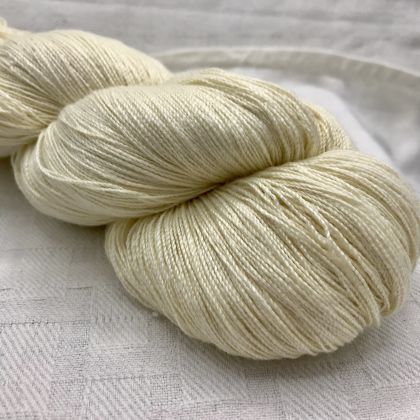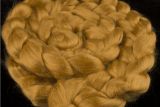OmShanti Red - 100% Red Eri (Wild Silk) Yarn, 20/2 lace weight
Eri silk is from the Samia ricini silk worm. Its silk is quite different than the silk from Bombyx mori. A few "races" of Samia ricini are naturally red. The red color is fugitive, so when it is processed, the color is a lovely warm cream color.
Our fantastic "silk guy" in India as gotten us mill spun red eri yarn (20/2 size). To his knowledge, this is the first time red eri has been spun in a mill.
Photos to the left:
1) OmShanti-Red
2) Shanta(top), L-R Kiku, OmShanti-white, OmShanti-red
3) Shanta(top), L-R Kiku, OmShanti-white, OmShanti-red
We ordered both red and white eri yarn--we think when both are woven in the same piece, you'll have a beautiful "white on white" creation.
The look and feel of eri silk is similar to that of cotton. But it has the properties of silk--it keeps the wearer cool in the summer and warm in the winter.
The silk fibers in the eri cocoons are all wound together. When viewed under a microscope, eri silk fibers are broader than those of bombyx mori silk or cotton.
Depending on how Eri is spun, the yarn can have very different properties...somewhat like wool (soft and a touch sticky) or linen (tight, strong fiber).
OmShanti White is mill spun, 20/2 It feels soft and light and the color is a lovely warm white. This compares quite differently in both color and feel to Shanta, our eri silk that is handspun on a takhli.
Our mill spun yarn follows the same high quality procedures as bombyx yarns--the yarn has been spun from combed fibers and gassed (to make the yarn smooth). Treenway Silks has used the same silk supplier in India for over 20 years and he consistently delivers top quality.
Comparing OmShanti (eri 20/2) to Kiku (bombyx 20/2), they are distinctly different yarns, showing off the properites of the silk from their different silk worms. One is not better than the other, they are just different.
OmShanti (eri 20/2) is light and soft, with a matte sheen. A skein of eri feels "fluffier" than Kiku (bombyx 20/2) and the warm white is slightly whiter, too.
Kiku is definitely shinier and looks more as one expects silk to look. This makes sense to me, as about 90% of silk production worldwide is from Bombyx mori--so that's the silk we know best.
ORDER DETAILS:
Our skeins sizes vary a bit in size, ranging between 90-110 grams, with the average skein being 100 grams.
We’ve listed the price for the AVERAGE weight skein. We charge by the gram, so if your skein is a bit lighter, you’ll pay a bit less and if your skein is a bit heavier, you’ll pay a bit more. If you need specific yardage for a project, please let us know in the comments section at check out so we can select the correct skein(s) for you.
Once your skein is pulled and weighed, we will adjust your price and then process your credit card. We will call you if we have any questions.
Color: Natural OR…for any of 100+ colors, order this yarn and then go to ‘Dye My Order’ to have your silk dyed for you.
Yarn Name Meaning: eternal peace for all of mankind (Sanskrit)
PEACE SILK? not really.
Silk is an eco-friendly product.
- Ahimsa silk is a patented term referring to an eco-friendly method of manufacturing spun mulberry silk
- Eri silk could be peace silk, but most likely it is not, as almost always the pupa is removed for feeding people or other animals
- Don't assume that because tussah, muga and eri silk are wild silks they are peace silks--muga and tussah are also reeled and the eri pupae are used for food--so check your sources.
- The only true peace silk is made from cocoons in which the pupa has matured into a moth. Most often this is for breeding purposes, and the quantity of this type of silk is very small.
- The caterpillars produced from the eggs resulting from all the matings from unstifled cocoons (200 to 500 eggs per moth) would not have enough food and they would die from starvation and neglect.
- Sericulture is a sustainable, renewable, environmentally friendly resource, giving millions of rural people a healthy, family-oriented lifestyle.
| yarn | approx. skein wt. | yd/lb | m/kg | yds/skein |
|---|---|---|---|---|
| 20/2 lace weight |
100g 3.5 oz |
5,000 | 10,000 | 1,100 |
| Plain Weave sett | Twill sett | |
|---|---|---|
|
*haven't had a chance to weave yet, estimating 18-20 |
*haven't had a chance to weave yet, estimating 22-24 |





